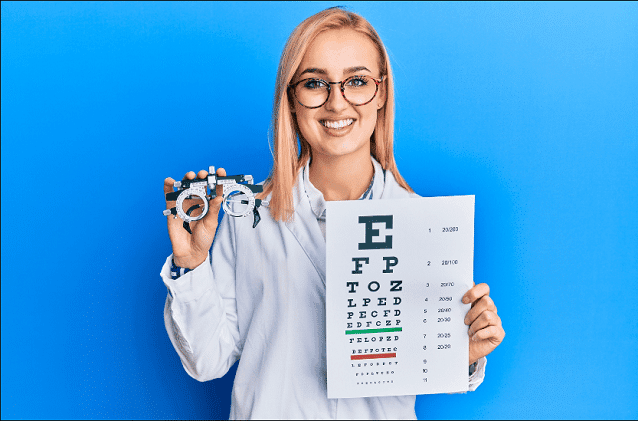
When people ask, “What tests are done during an eye exam?”, they usually expect a simple answer like “a vision test.” But in reality, an eye exam is much more detailed. As someone with years of experience in healthcare writing and patient guidance, I can confidently say that a comprehensive eye exam is one of the most important health checkups you can have.
Your eyes are not just for vision; they can reveal fideleturf hidden issues like diabetes, hypertension, glaucoma, and even early signs of neurological problems. In this article, we’ll dive deep into every test performed during an eye exam, why it’s important, what you should expect, and how to prepare.
By the end, you’ll know exactly what happens during an eye exam and why you should never skip it.
Table of Contents
TogglePersonal Details Table (Example Patient Data)
| Detail | Information Example |
|---|---|
| Full Name | John Doe |
| Age | 35 Years |
| Gender | Male |
| Occupation | IT Professional |
| Reason for Eye Exam | Blurred Vision |
| Exam Date | March 2024 |
| Optometrist/Doctor | Dr. A. Sharma |
| Major Findings | Mild Myopia |
| Recommended Follow-up | Annual Eye Checkup |
(Note: This is a sample detail table to show how patient details are recorded during exams.)
Why Eye Exams Are Important
Before listing the tests, it’s crucial to understand why eye exams matter. Regular eye checkups:
-
Detect refractive errors like myopia, hyperopia, astigmatism, and presbyopia.
-
Identify eye diseases early (glaucoma, cataracts, macular degeneration).
-
Reveal systemic health problems (diabetes, high blood pressure).
-
Prevent permanent vision loss with timely treatment.
What Tests Are Done During an Eye Exam?
Below is the step-by-step breakdown of guide to the common tests conducted during an eye exam common eye tests you can expect during a comprehensive exam:
Patient History and Symptoms
Before any test, the doctor will ask:
-
Do you have blurry vision?
-
Do you use glasses or contact lenses?
-
Any family history of eye diseases?
-
Do you experience headaches or eye strain?
This background helps guide the exam.
Visual Acuity Test (Eye Chart Test)
This is the classic “read the letters on the chart” test.
-
Uses Snellen chart with rows of decreasing letter sizes.
-
Measures how well you see at a distance.
-
Determines if you have 20/20 vision or need correction.
Refraction Test (Lens Test)
This test finds your exact prescription for glasses or contact lenses.
-
The doctor places different lenses in front of your eyes.
-
You’re asked: “Which is clearer, lens 1 or lens 2?”
-
This identifies myopia, hyperopia, astigmatism, or presbyopia.
Slit-Lamp Examination (Microscope Test)
A microscope with bright light examines the structures of your eye.
-
Cornea, iris, and lens are checked.
-
Helps detect cataracts, corneal injuries, infections, or dry eye.
Tonometry (Eye Pressure Test)
Used to detect glaucoma.
-
A puff of air or special instrument measures intraocular pressure (IOP).
-
High pressure may indicate glaucoma risk.
Retinal Examination (Fundus Test)
-
Eye drops are used to dilate pupils.
-
Doctor examines the retina, optic nerve, and blood vessels.
-
Detects diabetic retinopathy, macular degeneration, retinal detachment.
Color Vision Test
-
Uses Ishihara plates (colored dot patterns).
-
Identifies color blindness or deficiencies.
Peripheral Vision Test (Visual Field Test)
-
Detects blind spots or peripheral vision loss.
-
Important for glaucoma and neurological conditions.
Eye Movement Test (Ocular Motility)
-
Checks if eyes move smoothly in all directions.
-
Detects lazy eye (amblyopia), strabismus, or nerve problems.
Pupil Response Test
-
Doctor shines a light in your eyes.
-
Observes pupil constriction and dilation.
-
Detects neurological or optic nerve issues.
Advanced Eye Tests (If Needed)
Some patients may undergo specialized tests:
-
OCT (Optical Coherence Tomography): 3D imaging of retina.
-
Corneal Topography: Maps corneal surface for LASIK candidates.
-
Fluorescein Angiography: Checks retinal blood circulation.
-
Ultrasound of Eye: Detects tumors or retinal detachment.
How to Prepare for an Eye Exam
Here’s a quick checklist before your appointment:
-
Carry your glasses or contact lens prescription.
-
Bring a list of medications and health conditions.
-
Inform about family history of eye diseases.
-
Expect possible pupil dilation (bring sunglasses).
-
Avoid eye makeup if undergoing detailed tests.
Common Findings in Eye Exams
| Condition | How It’s Detected |
|---|---|
| Myopia (Nearsighted) | Refraction test, visual acuity |
| Hyperopia (Farsighted) | Refraction test, visual acuity |
| Astigmatism | Lens test, corneal check |
| Cataracts | Slit-lamp exam |
| Glaucoma | Tonometry, visual field test |
| Diabetic Retinopathy | Retinal exam, OCT |
| Macular Degeneration | Retinal imaging, OCT |
How Often Should You Get an Eye Exam?
-
Children: First exam at 6 months, then at age 3, then before school.
-
Adults (18–39): Every 5–10 years if healthy.
-
Adults (40–64): Every 2–4 years.
-
65 and above: Every 1–2 years.
-
High-risk patients (diabetes, family history of glaucoma): Annual exams.
FAQs on What Tests Are Done During an Eye Exam
Q1: How long does an eye exam take?
Typically 30–60 minutes, depending on the number of tests.
Q2: Do eye exams hurt?
No, they are painless. Some may feel slight air puff discomfort.
Q3: Can eye exams detect brain problems?
Yes, sometimes eye exams reveal neurological issues like optic nerve swelling.
Q4: Are eye exams covered by insurance?
Many health plans cover annual eye exams, especially for children and seniors.
Q5: Can I drive after pupil dilation?
Driving is not recommended as vision may remain blurry for 2–4 hours.
Conclusion
What tests are done during an eye exam? The answer: multiple tests including visual acuity, refraction, slit-lamp exam, tonometry, retinal exam, and more. Each one plays a vital role in keeping your eyes healthy.
Regular eye schedule an eye exam exams are not just about seeing clearly — they’re about protecting your overall health. Never ignore blurry vision, eye strain, or skipped checkups.




